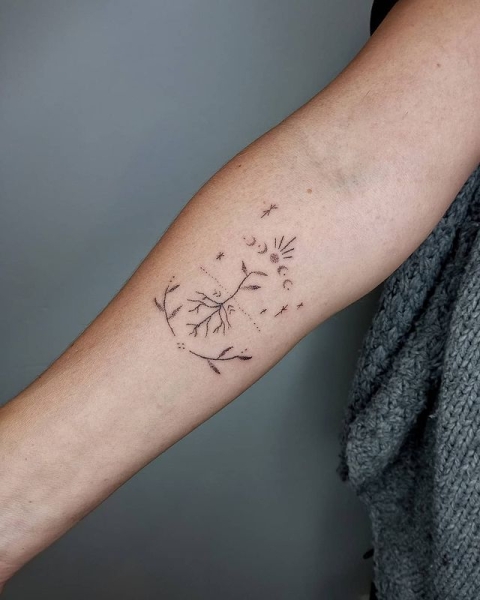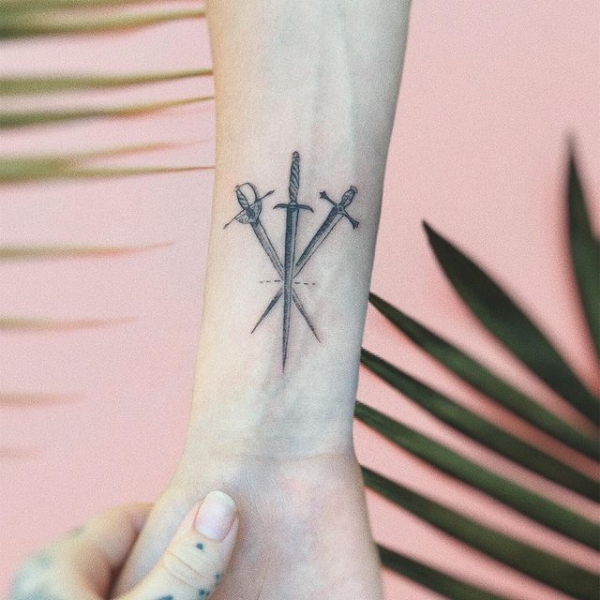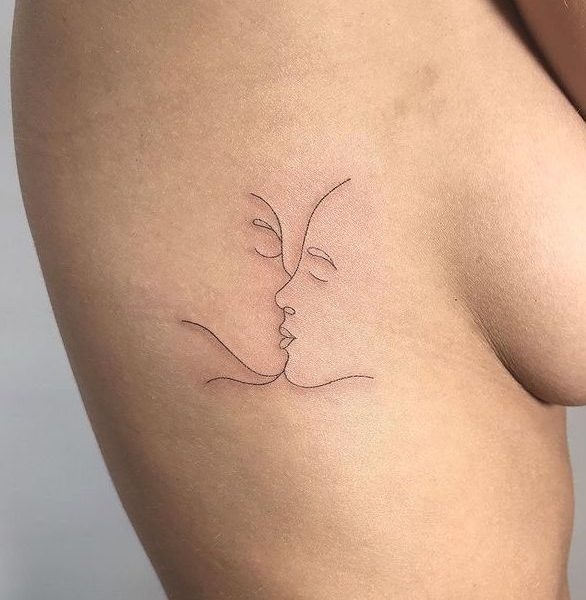Contents
What are Hand Poked tattoos?
Hand poked tattoos (aka Stick & Poke, aka Handpoke) is a form of tattooing without a tattoo machine. It’s called that way because it’s made by hand: it involves using a sharp point (or a stick) and some ink and then repeatedly puncturing the skin and dragging the ink into the dermis to create the desired patterns.
The technique is not new, much on the contrary, it’s the oldest form of tattooing and continues to be practiced today both in and out of ancient/ ritual / tribal traditions.
It should be done by experienced artists, but due to it’s easy-to-start nature, several people do it on themselves and in others with little to no experience (and for this reason some people call these DIY tattoos).
Is there a difference between Hand poked and normal tattoos?
The stick and poke tattooing technique causes less trauma to the skin and also heals quicker than machine tattooing. The reason for this is that the amount of needles used is much inferior: only one when done by hand compared to generally groups of 5 to 9 when done by machine, which can be over 20 depending on the need. Oftentimes the handpoke leaves less scabs and requires somewhat less aftercare compared to machine tattoos.
There is also a difference in the frequency of times the ink is inserted into the skin. A modern machine can pierce the skin up to 3000 times a minute – there’s no way a human hand can even compare to that. Still, this does not mean the tattoo will look worse or better if made by hand – that depends on the artist’s skill – it’s just goes to show why you’ll have less scarring to do after a handpoke tattoo,

Hand Poke work made by Deborah Joyce
Does it require additional skills from the artist?
The basis is very similar: You have to know how to tattoo, use safe and clean tools and be skilled at putting the ink on the skin. And then, if you want to specialize on hand poke you have to accept that some things will be harder to do (colouring, wide areas, straight lines, long pieces, etc.), but that the technique also gives you other strengths.
Are there colored handpoke tattoos?
There are colored hand-poked tattoos. You can choose a color besides black and proceed to color the tattoo, or you can also apply different techniques. Handpoke does not mean you have to use only one needle.
Are there online courses to learn the Stick and Poke technique?
Yes, you can learn online.
Below are the courses with the best cost-benefit we could find online:
Fundamentals and techniques for doing a professional hand poked tattoo (24,99$)


Learn Stick and Poke Tattooing from scratch – The complete guide to ritual hand-tattoos (84,99$)


What material do I need to get started?
These are the essential tools needed to perform hand-poked tattoos properly:
- Sterile Tattoo Needle
- Tattoo Ink & Ink Cups
- Medical Exam Gloves and Surface Cover
- Alcohol Preparation Pads
- Fresh Disposal Razor and Disposable Sharps Container
- Witch Hazel Wipes
As I have said above, any artist can do this style of tattooing as long as the artist uses clean tools and sterilizes the needle properly.
What are the steps prior to doing a hand-poked tattoo?
- First, you create a safe and clean working environment, ensuring it has been fully disinfected
- Clean or shave the surface if necessary, using a disposable razor
- Layout arranged equipment for the tattoo
- Put on your surgical gloves.
- Clean the area to be tattooed on, by rubbing the alcoholic pad tightly in circles
- Use the correct stencil transfer gel to apply the stencil onto the skin
- Allow the stencil to dry for about 5-10 minutes. When the stencil is being applied, clean it away quickly and reapply the same stencil once more. That same stencil may be reused many times.
- Pour in a clean bottle or a mini jar, with the ink preferred color. Mix it, dilute the inks for a lighter effect
- Then you begin tattooing.

Hand Poke work made by Die_monde
How do I practice?
You can practice hand-poked tattoos using different materials such as fruits (oranges, melons, etc.), pig skins, silicone, and borosilicate glass. The commonly used materials are the silicone type which is very similar to that of the borosilicate glass. However, during tattooing, we observed that each product behaves differently. The differences appeared when removing the ink.
- The silicone tattoo practice skin is soft and flexible. It accepts ink similarly to real skin and it is easier to clean than the borosilicate glass. It exists under different forms even in the body parts like hands. The sheets are less than 10$ which is to say that they are more affordable.
- The borosilicate glass tattoo practice skin was also flexible, but more breakable than the silicone one. It feels more penetrable than the silicone and is much difficult to clean even with the use of alcohol.
- Pigskins also take in ink well. This product can be found at the butcher, it usually has a reputation of being smelly but the feelings as real as the ski if going with this option you should get a tender part.
- Fruits, when talking about this the family of orange comes to mind when thinking of practicing tattoo because of their porous skin. Bananas also can be used but won’t last long. Moreover, the feeling is far from real skin in both cases.
Can I use ink from a pen for a Stick and Poke?
The ink from a pen can technically be used but it is never advisable to do so. The pen contains alcohol, dyes, and glycol (chemical gel). The glycol is considered to be toxic in large amounts but because the amount in the pen is reduced it’s usually not enough to be toxic. The issue is that when one wants to insert or put ink in the skin that directly connects to the bloodstream, you should use the safest ink possible, otherwise it can result in skin infection, stained skin and blowout or getting sick.

Hand Poke work made by Lydia Amor
Is there a tradition associated with these tattoos?
Handpoke tattoos are the oldest form of tattooing. It was the way Ötzi got tattooed, as well most tribal folks. If we had to trace the modern origin of stick and poke to a specific practice it would be the Tebori from Japan. It was before the advent of tattoo machine and involved the intricate application of their traditional artwork tattooed onto the body by hand. The word “Tebori” meaning “hand-sculpting” and is mainly the Japanese equivalent of the hand poke techniques. The stick and poke techniques were used to tattoo simple and stylized designs. The hand poke style of a tattoo can be as dot-work and was by a significant accumulation of dots, close to each, that creates designs, shapes, and lines.
There are also terms by which artists call the different elements of the tradition. Which are:
- Bokashi: is a black gradient shade that is often used to make clouds and decorative trails;
- Kakashi-bori: is a term that refers to drawings close to the armpit or hidden points on the body.it is also used to indicate numbers or words hidden among the flower petals;
- Kebori: a word used to portray very fine lines, such as those of hair
- Kershaw-bori: secondary pictures to support the main drawing;
- Suji-bori: is a the edges of the design
- Nuki-born: the main drawing without the support of the secondary drawings
- New-born: an artist that has to tattoo a character from the tebori tradition that is also tattooed, the character’s tattoos must be exactly reproduced by the artist on the client body
More content you might like
Best Tattoo Artist Courses
The complete History of Tattoos
How to Improve Your Tattoo Artist Skills
Cover photo by Faye Oliver
